

SEO check"An SEO check involves analyzing a websites performance to identify strengths and weaknesses. By reviewing on-page elements, technical issues, and backlink profiles, businesses can pinpoint areas for improvement and develop strategies to enhance their search rankings."
SEO companies in Australia"SEO companies in Australia offer comprehensive services designed to improve website rankings and increase organic traffic. By combining technical expertise, creative content strategies, and data analysis, these companies help businesses achieve sustainable growth and build a strong online presence."
SEO company in Sydney"A reputable SEO company in Sydney offers businesses a full suite of optimization services, including keyword research, on-page optimization, and backlink strategies. Best SEO Agency Sydney Australia.
SEO company in Sydney"A reputable SEO company in Sydney offers businesses a full suite of optimization services, including keyword research, on-page optimization, and backlink strategies. By delivering customized solutions, these companies help clients achieve higher rankings and long-term success."
SEO company Sydney"An SEO company in Sydney provides businesses with customized optimization solutions that improve search rankings and drive traffic. By offering services like keyword research, content creation, technical audits, and link building, these companies help clients achieve their digital marketing goals."
SEO consultant"A professional SEO consultant provides businesses with the expertise needed to improve search rankings and increase organic traffic. By conducting detailed audits, identifying keyword opportunities, and implementing tailored strategies, these consultants deliver measurable improvements."
Best Search Engine Optimisation Services.SEO consultant Sydney"A skilled SEO consultant in Sydney provides businesses with personalized guidance and expertise to improve their search rankings.
SEO consultant Sydney"A skilled SEO consultant in Sydney provides businesses with personalized guidance and expertise to improve their search rankings. By conducting in-depth audits, identifying keyword opportunities, and implementing targeted strategies, these consultants help clients achieve long-term success in their digital marketing efforts."
SEO consultants Sydney"Sydney-based SEO consultants provide expert guidance to improve search rankings, increase organic traffic, and drive conversions. With a focus on data-driven strategies and continuous improvement, these consultants help businesses achieve sustainable growth."
SEO Packages Sydney .

SEO content marketing"SEO content marketing focuses on creating high-quality, keyword-optimized content that drives organic traffic. By combining SEO best practices with engaging storytelling, businesses can improve search rankings, attract more visitors, and convert readers into customers."
SEO conversion optimization"SEO conversion optimization involves creating content and calls-to-action that guide visitors toward completing desired actions. By combining effective SEO techniques with user-friendly design and clear messaging, businesses can increase conversions and maximize the return on their optimization efforts."
SEO copywriting"SEO copywriting combines engaging content with strategic keyword usage. By crafting compelling, informative, and keyword-optimized copy, businesses can improve rankings, attract more visitors, and convert readers into customers."
SEO cost analysis"SEO cost analysis helps businesses understand the financial investment required for effective optimization. By evaluating tools, services, and time commitments, companies can make informed decisions and ensure they allocate resources efficiently for the best results."
SEO expert"An SEO expert provides businesses with the guidance and strategies needed to improve their search rankings. By analyzing data, optimizing website elements, and implementing proven techniques, these experts help clients achieve sustainable growth and a strong online presence."
SEO expert Sydney"A seasoned SEO expert in Sydney helps businesses navigate the complexities of search engine optimization. By analyzing data, refining strategies, and staying current with algorithm changes, these experts deliver measurable improvements in search rankings and website performance."


SEO expert Sydney"A seasoned SEO expert in Sydney helps businesses navigate the complexities of search engine optimization. By analyzing data, refining strategies, and staying current with algorithm changes, these experts deliver measurable improvements in search rankings and website performance."
SEO experts"SEO experts specialize in improving website performance, increasing organic traffic, and enhancing search rankings. By leveraging advanced techniques, data-driven strategies, and industry best practices, these experts help businesses achieve measurable and lasting results."
SEO experts Sydney"SEO experts in Sydney combine technical knowledge, creative strategies, and industry insights to deliver outstanding results.
SEO experts Sydney"SEO experts in Sydney combine technical knowledge, creative strategies, and industry insights to deliver outstanding results. With a focus on data-driven decision-making and continuous improvement, these experts help businesses achieve and maintain top search rankings."
SEO for blogs"SEO for blogs focuses on optimizing individual blog posts with relevant keywords, compelling meta descriptions, and clear headings. By creating well-structured, valuable content, bloggers can attract more readers, rank higher in search results, and build a loyal audience."
SEO for ecommerce"SEO for ecommerce focuses on optimizing product pages, category pages, and site structure to increase visibility and drive sales. By targeting transactional keywords, improving page speed, and implementing schema markup, ecommerce businesses can attract more customers and increase revenue."

| Abbreviation | WWW |
|---|---|
| Year started | 1989 by Tim Berners-Lee |
| Organization |

The World Wide Web (WWW or simply the Web) is an information system that enables content sharing over the Internet through user-friendly ways meant to appeal to users beyond IT specialists and hobbyists.[1] It allows documents and other web resources to be accessed over the Internet according to specific rules of the Hypertext Transfer Protocol (HTTP).[2]
The Web was invented by English computer scientist Tim Berners-Lee while at CERN in 1989 and opened to the public in 1993. It was conceived as a "universal linked information system".[3][4][5] Documents and other media content are made available to the network through web servers and can be accessed by programs such as web browsers. Servers and resources on the World Wide Web are identified and located through character strings called uniform resource locators (URLs).
The original and still very common document type is a web page formatted in Hypertext Markup Language (HTML). This markup language supports plain text, images, embedded video and audio contents, and scripts (short programs) that implement complex user interaction. The HTML language also supports hyperlinks (embedded URLs) which provide immediate access to other web resources. Web navigation, or web surfing, is the common practice of following such hyperlinks across multiple websites. Web applications are web pages that function as application software. The information in the Web is transferred across the Internet using HTTP. Multiple web resources with a common theme and usually a common domain name make up a website. A single web server may provide multiple websites, while some websites, especially the most popular ones, may be provided by multiple servers. Website content is provided by a myriad of companies, organizations, government agencies, and individual users; and comprises an enormous amount of educational, entertainment, commercial, and government information.
The Web has become the world's dominant information systems platform.[6][7][8][9] It is the primary tool that billions of people worldwide use to interact with the Internet.[2]
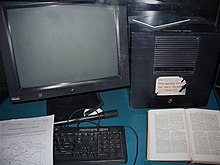
The Web was invented by English computer scientist Tim Berners-Lee while working at CERN.[10][11] He was motivated by the problem of storing, updating, and finding documents and data files in that large and constantly changing organization, as well as distributing them to collaborators outside CERN. In his design, Berners-Lee dismissed the common tree structure approach, used for instance in the existing CERNDOC documentation system and in the Unix filesystem, as well as approaches that relied in tagging files with keywords, as in the VAX/NOTES system. Instead he adopted concepts he had put into practice with his private ENQUIRE system (1980) built at CERN. When he became aware of Ted Nelson's hypertext model (1965), in which documents can be linked in unconstrained ways through hyperlinks associated with "hot spots" embedded in the text, it helped to confirm the validity of his concept.[12][13]

The model was later popularized by Apple's HyperCard system. Unlike Hypercard, Berners-Lee's new system from the outset was meant to support links between multiple databases on independent computers, and to allow simultaneous access by many users from any computer on the Internet. He also specified that the system should eventually handle other media besides text, such as graphics, speech, and video. Links could refer to mutable data files, or even fire up programs on their server computer. He also conceived "gateways" that would allow access through the new system to documents organized in other ways (such as traditional computer file systems or the Usenet). Finally, he insisted that the system should be decentralized, without any central control or coordination over the creation of links.[4][14][10][11]
Berners-Lee submitted a proposal to CERN in May 1989, without giving the system a name.[4] He got a working system implemented by the end of 1990, including a browser called WorldWideWeb (which became the name of the project and of the network) and an HTTP server running at CERN. As part of that development he defined the first version of the HTTP protocol, the basic URL syntax, and implicitly made HTML the primary document format.[15] The technology was released outside CERN to other research institutions starting in January 1991, and then to the whole Internet on 23 August 1991. The Web was a success at CERN, and began to spread to other scientific and academic institutions. Within the next two years, there were 50 websites created.[16][17]
CERN made the Web protocol and code available royalty free in 1993, enabling its widespread use.[18][19] After the NCSA released the Mosaic web browser later that year, the Web's popularity grew rapidly as thousands of websites sprang up in less than a year.[20][21] Mosaic was a graphical browser that could display inline images and submit forms that were processed by the HTTPd server.[22][23] Marc Andreessen and Jim Clark founded Netscape the following year and released the Navigator browser, which introduced Java and JavaScript to the Web. It quickly became the dominant browser. Netscape became a public company in 1995 which triggered a frenzy for the Web and started the dot-com bubble.[24] Microsoft responded by developing its own browser, Internet Explorer, starting the browser wars. By bundling it with Windows, it became the dominant browser for 14 years.[25]
Berners-Lee founded the World Wide Web Consortium (W3C) which created XML in 1996 and recommended replacing HTML with stricter XHTML.[26] In the meantime, developers began exploiting an IE feature called XMLHttpRequest to make Ajax applications and launched the Web 2.0 revolution. Mozilla, Opera, and Apple rejected XHTML and created the WHATWG which developed HTML5.[27] In 2009, the W3C conceded and abandoned XHTML.[28] In 2019, it ceded control of the HTML specification to the WHATWG.[29]
The World Wide Web has been central to the development of the Information Age and is the primary tool billions of people use to interact on the Internet.[30][31][32][9]
|
This section needs additional citations for verification. (August 2023)
|
Tim Berners-Lee states that World Wide Web is officially spelled as three separate words, each capitalised, with no intervening hyphens.[33] Nonetheless, it is often called simply the Web, and also often the web; see Capitalization of Internet for details. In Mandarin Chinese, World Wide Web is commonly translated via a phono-semantic matching to wàn wéi wÇŽng (万维网), which satisfies www and literally means "10,000-dimensional net", a translation that reflects the design concept and proliferation of the World Wide Web.
Use of the www prefix has been declining, especially when web applications sought to brand their domain names and make them easily pronounceable. As the mobile Web grew in popularity,[citation needed] services like Gmail.com, Outlook.com, Myspace.com, Facebook.com and Twitter.com are most often mentioned without adding "www." (or, indeed, ".com") to the domain.[34]
In English, www is usually read as double-u double-u double-u.[35] Some users pronounce it dub-dub-dub, particularly in New Zealand.[36] Stephen Fry, in his "Podgrams" series of podcasts, pronounces it wuh wuh wuh.[37] The English writer Douglas Adams once quipped in The Independent on Sunday (1999): "The World Wide Web is the only thing I know of whose shortened form takes three times longer to say than what it's short for".[38]

The terms Internet and World Wide Web are often used without much distinction. However, the two terms do not mean the same thing. The Internet is a global system of computer networks interconnected through telecommunications and optical networking. In contrast, the World Wide Web is a global collection of documents and other resources, linked by hyperlinks and URIs. Web resources are accessed using HTTP or HTTPS, which are application-level Internet protocols that use the Internet transport protocols.[2]
Viewing a web page on the World Wide Web normally begins either by typing the URL of the page into a web browser or by following a hyperlink to that page or resource. The web browser then initiates a series of background communication messages to fetch and display the requested page. In the 1990s, using a browser to view web pages—and to move from one web page to another through hyperlinks—came to be known as 'browsing,' 'web surfing' (after channel surfing), or 'navigating the Web'. Early studies of this new behaviour investigated user patterns in using web browsers. One study, for example, found five user patterns: exploratory surfing, window surfing, evolved surfing, bounded navigation and targeted navigation.[39]
The following example demonstrates the functioning of a web browser when accessing a page at the URL http://example.org/home.html. The browser resolves the server name of the URL (example.org) into an Internet Protocol address using the globally distributed Domain Name System (DNS). This lookup returns an IP address such as 203.0.113.4 or 2001:db8:2e::7334. The browser then requests the resource by sending an HTTP request across the Internet to the computer at that address. It requests service from a specific TCP port number that is well known for the HTTP service so that the receiving host can distinguish an HTTP request from other network protocols it may be servicing. HTTP normally uses port number 80 and for HTTPS it normally uses port number 443. The content of the HTTP request can be as simple as two lines of text:
GET /home.html HTTP/1.1
Host: example.org
The computer receiving the HTTP request delivers it to web server software listening for requests on port 80. If the web server can fulfil the request it sends an HTTP response back to the browser indicating success:
HTTP/1.1 200 OK
Content-Type: text/html; charset=UTF-8
followed by the content of the requested page. Hypertext Markup Language (HTML) for a basic web page might look like this:
<html>
<head>
<title>Example.org – The World Wide Web</title>
</head>
<body>
<p>The World Wide Web, abbreviated as WWW and commonly known ...</p>
</body>
</html>
The web browser parses the HTML and interprets the markup (<title>, <p> for paragraph, and such) that surrounds the words to format the text on the screen. Many web pages use HTML to reference the URLs of other resources such as images, other embedded media, scripts that affect page behaviour, and Cascading Style Sheets that affect page layout. The browser makes additional HTTP requests to the web server for these other Internet media types. As it receives their content from the web server, the browser progressively renders the page onto the screen as specified by its HTML and these additional resources.
Hypertext Markup Language (HTML) is the standard markup language for creating web pages and web applications. With Cascading Style Sheets (CSS) and JavaScript, it forms a triad of cornerstone technologies for the World Wide Web.[40]
Web browsers receive HTML documents from a web server or from local storage and render the documents into multimedia web pages. HTML describes the structure of a web page semantically and originally included cues for the appearance of the document.
HTML elements are the building blocks of HTML pages. With HTML constructs, images and other objects such as interactive forms may be embedded into the rendered page. HTML provides a means to create structured documents by denoting structural semantics for text such as headings, paragraphs, lists, links, quotes and other items. HTML elements are delineated by tags, written using angle brackets. Tags such as <img /> and <input /> directly introduce content into the page. Other tags such as <p> surround and provide information about document text and may include other tags as sub-elements. Browsers do not display the HTML tags, but use them to interpret the content of the page.
HTML can embed programs written in a scripting language such as JavaScript, which affects the behaviour and content of web pages. Inclusion of CSS defines the look and layout of content. The World Wide Web Consortium (W3C), maintainer of both the HTML and the CSS standards, has encouraged the use of CSS over explicit presentational HTML since 1997.[update][41]
Most web pages contain hyperlinks to other related pages and perhaps to downloadable files, source documents, definitions and other web resources. In the underlying HTML, a hyperlink looks like this: <a href="http://example.org/home.html">Example.org Homepage</a>.
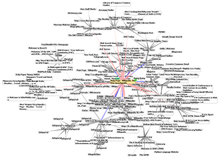
Such a collection of useful, related resources, interconnected via hypertext links is dubbed a web of information. Publication on the Internet created what Tim Berners-Lee first called the WorldWideWeb (in its original CamelCase, which was subsequently discarded) in November 1990.[42]
The hyperlink structure of the web is described by the webgraph: the nodes of the web graph correspond to the web pages (or URLs) the directed edges between them to the hyperlinks. Over time, many web resources pointed to by hyperlinks disappear, relocate, or are replaced with different content. This makes hyperlinks obsolete, a phenomenon referred to in some circles as link rot, and the hyperlinks affected by it are often called "dead" links. The ephemeral nature of the Web has prompted many efforts to archive websites. The Internet Archive, active since 1996, is the best known of such efforts.
Many hostnames used for the World Wide Web begin with www because of the long-standing practice of naming Internet hosts according to the services they provide. The hostname of a web server is often www, in the same way that it may be ftp for an FTP server, and news or nntp for a Usenet news server. These hostnames appear as Domain Name System (DNS) or subdomain names, as in www.example.com. The use of www is not required by any technical or policy standard and many websites do not use it; the first web server was nxoc01.cern.ch.[43] According to Paolo Palazzi, who worked at CERN along with Tim Berners-Lee, the popular use of www as subdomain was accidental; the World Wide Web project page was intended to be published at www.cern.ch while info.cern.ch was intended to be the CERN home page; however the DNS records were never switched, and the practice of prepending www to an institution's website domain name was subsequently copied.[44][better source needed] Many established websites still use the prefix, or they employ other subdomain names such as www2, secure or en for special purposes. Many such web servers are set up so that both the main domain name (e.g., example.com) and the www subdomain (e.g., www.example.com) refer to the same site; others require one form or the other, or they may map to different web sites. The use of a subdomain name is useful for load balancing incoming web traffic by creating a CNAME record that points to a cluster of web servers. Since, currently[as of?], only a subdomain can be used in a CNAME, the same result cannot be achieved by using the bare domain root.[45][dubious – discuss]
When a user submits an incomplete domain name to a web browser in its address bar input field, some web browsers automatically try adding the prefix "www" to the beginning of it and possibly ".com", ".org" and ".net" at the end, depending on what might be missing. For example, entering "microsoft" may be transformed to http://www.microsoft.com/ and "openoffice" to http://www.openoffice.org. This feature started appearing in early versions of Firefox, when it still had the working title 'Firebird' in early 2003, from an earlier practice in browsers such as Lynx.[46] [unreliable source?] It is reported that Microsoft was granted a US patent for the same idea in 2008, but only for mobile devices.[47]
The scheme specifiers http:// and https:// at the start of a web URI refer to Hypertext Transfer Protocol or HTTP Secure, respectively. They specify the communication protocol to use for the request and response. The HTTP protocol is fundamental to the operation of the World Wide Web, and the added encryption layer in HTTPS is essential when browsers send or retrieve confidential data, such as passwords or banking information. Web browsers usually automatically prepend http:// to user-entered URIs, if omitted.
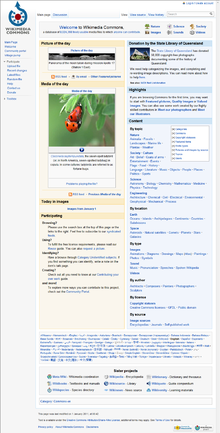
A web page (also written as webpage) is a document that is suitable for the World Wide Web and web browsers. A web browser displays a web page on a monitor or mobile device.
The term web page usually refers to what is visible, but may also refer to the contents of the computer file itself, which is usually a text file containing hypertext written in HTML or a comparable markup language. Typical web pages provide hypertext for browsing to other web pages via hyperlinks, often referred to as links. Web browsers will frequently have to access multiple web resource elements, such as reading style sheets, scripts, and images, while presenting each web page.
On a network, a web browser can retrieve a web page from a remote web server. The web server may restrict access to a private network such as a corporate intranet. The web browser uses the Hypertext Transfer Protocol (HTTP) to make such requests to the web server.
A static web page is delivered exactly as stored, as web content in the web server's file system. In contrast, a dynamic web page is generated by a web application, usually driven by server-side software. Dynamic web pages are used when each user may require completely different information, for example, bank websites, web email etc.
A static web page (sometimes called a flat page/stationary page) is a web page that is delivered to the user exactly as stored, in contrast to dynamic web pages which are generated by a web application.
Consequently, a static web page displays the same information for all users, from all contexts, subject to modern capabilities of a web server to negotiate content-type or language of the document where such versions are available and the server is configured to do so.

A server-side dynamic web page is a web page whose construction is controlled by an application server processing server-side scripts. In server-side scripting, parameters determine how the assembly of every new web page proceeds, including the setting up of more client-side processing.
A client-side dynamic web page processes the web page using JavaScript running in the browser. JavaScript programs can interact with the document via Document Object Model, or DOM, to query page state and alter it. The same client-side techniques can then dynamically update or change the DOM in the same way.
A dynamic web page is then reloaded by the user or by a computer program to change some variable content. The updating information could come from the server, or from changes made to that page's DOM. This may or may not truncate the browsing history or create a saved version to go back to, but a dynamic web page update using Ajax technologies will neither create a page to go back to nor truncate the web browsing history forward of the displayed page. Using Ajax technologies the end user gets one dynamic page managed as a single page in the web browser while the actual web content rendered on that page can vary. The Ajax engine sits only on the browser requesting parts of its DOM, the DOM, for its client, from an application server.
Dynamic HTML, or DHTML, is the umbrella term for technologies and methods used to create web pages that are not static web pages, though it has fallen out of common use since the popularization of AJAX, a term which is now itself rarely used.[citation needed] Client-side-scripting, server-side scripting, or a combination of these make for the dynamic web experience in a browser.
JavaScript is a scripting language that was initially developed in 1995 by Brendan Eich, then of Netscape, for use within web pages.[48] The standardised version is ECMAScript.[48] To make web pages more interactive, some web applications also use JavaScript techniques such as Ajax (asynchronous JavaScript and XML). Client-side script is delivered with the page that can make additional HTTP requests to the server, either in response to user actions such as mouse movements or clicks, or based on elapsed time. The server's responses are used to modify the current page rather than creating a new page with each response, so the server needs only to provide limited, incremental information. Multiple Ajax requests can be handled at the same time, and users can interact with the page while data is retrieved. Web pages may also regularly poll the server to check whether new information is available.[49]
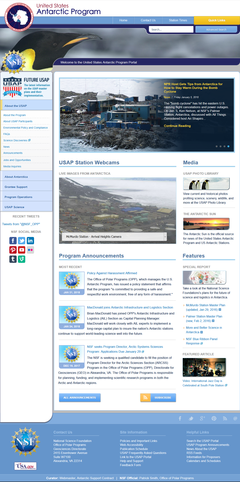
A website[50] is a collection of related web resources including web pages, multimedia content, typically identified with a common domain name, and published on at least one web server. Notable examples are wikipedia.org, google.com, and amazon.com.
A website may be accessible via a public Internet Protocol (IP) network, such as the Internet, or a private local area network (LAN), by referencing a uniform resource locator (URL) that identifies the site.
Websites can have many functions and can be used in various fashions; a website can be a personal website, a corporate website for a company, a government website, an organization website, etc. Websites are typically dedicated to a particular topic or purpose, ranging from entertainment and social networking to providing news and education. All publicly accessible websites collectively constitute the World Wide Web, while private websites, such as a company's website for its employees, are typically a part of an intranet.
Web pages, which are the building blocks of websites, are documents, typically composed in plain text interspersed with formatting instructions of Hypertext Markup Language (HTML, XHTML). They may incorporate elements from other websites with suitable markup anchors. Web pages are accessed and transported with the Hypertext Transfer Protocol (HTTP), which may optionally employ encryption (HTTP Secure, HTTPS) to provide security and privacy for the user. The user's application, often a web browser, renders the page content according to its HTML markup instructions onto a display terminal.
Hyperlinking between web pages conveys to the reader the site structure and guides the navigation of the site, which often starts with a home page containing a directory of the site web content. Some websites require user registration or subscription to access content. Examples of subscription websites include many business sites, news websites, academic journal websites, gaming websites, file-sharing websites, message boards, web-based email, social networking websites, websites providing real-time price quotations for different types of markets, as well as sites providing various other services. End users can access websites on a range of devices, including desktop and laptop computers, tablet computers, smartphones and smart TVs.
A web browser (commonly referred to as a browser) is a software user agent for accessing information on the World Wide Web. To connect to a website's server and display its pages, a user needs to have a web browser program. This is the program that the user runs to download, format, and display a web page on the user's computer.
In addition to allowing users to find, display, and move between web pages, a web browser will usually have features like keeping bookmarks, recording history, managing cookies (see below), and home pages and may have facilities for recording passwords for logging into websites.
The most popular browsers are Chrome, Safari, Edge, Samsung Internet and Firefox.[51]
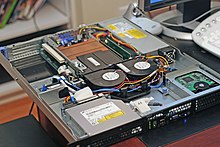
A Web server is server software, or hardware dedicated to running said software, that can satisfy World Wide Web client requests. A web server can, in general, contain one or more websites. A web server processes incoming network requests over HTTP and several other related protocols.
The primary function of a web server is to store, process and deliver web pages to clients.[52] The communication between client and server takes place using the Hypertext Transfer Protocol (HTTP). Pages delivered are most frequently HTML documents, which may include images, style sheets and scripts in addition to the text content.

A user agent, commonly a web browser or web crawler, initiates communication by making a request for a specific resource using HTTP and the server responds with the content of that resource or an error message if unable to do so. The resource is typically a real file on the server's secondary storage, but this is not necessarily the case and depends on how the webserver is implemented.
While the primary function is to serve content, full implementation of HTTP also includes ways of receiving content from clients. This feature is used for submitting web forms, including uploading of files.
Many generic web servers also support server-side scripting using Active Server Pages (ASP), PHP (Hypertext Preprocessor), or other scripting languages. This means that the behaviour of the webserver can be scripted in separate files, while the actual server software remains unchanged. Usually, this function is used to generate HTML documents dynamically ("on-the-fly") as opposed to returning static documents. The former is primarily used for retrieving or modifying information from databases. The latter is typically much faster and more easily cached but cannot deliver dynamic content.
Web servers can also frequently be found embedded in devices such as printers, routers, webcams and serving only a local network. The web server may then be used as a part of a system for monitoring or administering the device in question. This usually means that no additional software has to be installed on the client computer since only a web browser is required (which now is included with most operating systems).
Optical networking is a sophisticated infrastructure that utilizes optical fiber to transmit data over long distances, connecting countries, cities, and even private residences. The technology uses optical microsystems like tunable lasers, filters, attenuators, switches, and wavelength-selective switches to manage and operate these networks.[53][54]
The large quantity of optical fiber installed throughout the world at the end of the twentieth century set the foundation of the Internet as it’s used today. The information highway relies heavily on optical networking, a method of sending messages encoded in light to relay information in various telecommunication networks.[55]
The Advanced Research Projects Agency Network (ARPANET) was one of the first iterations of the Internet, created in collaboration with universities and researchers 1969.[56][57][58][59] However, access to the ARPANET was limited to researchers, and in 1985, the National Science Foundation founded the National Science Foundation Network (NSFNET), a program that provided supercomputer access to researchers.[59]
Limited public access to the Internet led to pressure from consumers and corporations to privatize the network. In 1993, the US passed the National Information Infrastructure Act, which dictated that the National Science Foundation must hand over control of the optical capabilities to commercial operators.[60][61]
The privatization of the Internet and the release of the World Wide Web to the public in 1993 led to an increased demand for Internet capabilities. This spurred developers to seek solutions to reduce the time and cost of laying new fiber and increase the amount of information that can be sent on a single fiber, in order to meet the growing needs of the public.[62][63][64][65]
In 1994, Pirelli S.p.A.'s optical components division introduced a wavelength-division multiplexing (WDM) system to meet growing demand for increased data transmission. This four-channel WDM technology allowed more information to be sent simultaneously over a single optical fiber, effectively boosting network capacity.[66][67]
Pirelli wasn't the only company that developed a WDM system; another company, the Ciena Corporation (Ciena), created its own technology to transmit data more efficiently. David Huber, an optical networking engineer and entrepreneur Kevin Kimberlin founded Ciena in 1992.[68][69][70] Drawing on laser technology from Gordon Gould and William Culver of Optelecom, Inc., the company focused on utilizing optical amplifiers to transmit data via light.[71][72][73] Under chief executive officer Pat Nettles, Ciena developed a dual-stage optical amplifier for dense wavelength-division multiplexing (DWDM), patented in 1997 and deployed on the Sprint network in 1996.[74][75][76][77][78]
An HTTP cookie (also called web cookie, Internet cookie, browser cookie, or simply cookie) is a small piece of data sent from a website and stored on the user's computer by the user's web browser while the user is browsing. Cookies were designed to be a reliable mechanism for websites to remember stateful information (such as items added in the shopping cart in an online store) or to record the user's browsing activity (including clicking particular buttons, logging in, or recording which pages were visited in the past). They can also be used to remember arbitrary pieces of information that the user previously entered into form fields such as names, addresses, passwords, and credit card numbers.
Cookies perform essential functions in the modern web. Perhaps most importantly, authentication cookies are the most common method used by web servers to know whether the user is logged in or not, and which account they are logged in with. Without such a mechanism, the site would not know whether to send a page containing sensitive information or require the user to authenticate themselves by logging in. The security of an authentication cookie generally depends on the security of the issuing website and the user's web browser, and on whether the cookie data is encrypted. Security vulnerabilities may allow a cookie's data to be read by a hacker, used to gain access to user data, or used to gain access (with the user's credentials) to the website to which the cookie belongs (see cross-site scripting and cross-site request forgery for examples).[79]
Tracking cookies, and especially third-party tracking cookies, are commonly used as ways to compile long-term records of individuals' browsing histories – a potential privacy concern that prompted European[80] and U.S. lawmakers to take action in 2011.[81][82] European law requires that all websites targeting European Union member states gain "informed consent" from users before storing non-essential cookies on their device.
Google Project Zero researcher Jann Horn describes ways cookies can be read by intermediaries, like Wi-Fi hotspot providers. When in such circumstances, he recommends using the browser in private browsing mode (widely known as Incognito mode in Google Chrome).[83]

A web search engine or Internet search engine is a software system that is designed to carry out web search (Internet search), which means to search the World Wide Web in a systematic way for particular information specified in a web search query. The search results are generally presented in a line of results, often referred to as search engine results pages (SERPs). The information may be a mix of web pages, images, videos, infographics, articles, research papers, and other types of files. Some search engines also mine data available in databases or open directories. Unlike web directories, which are maintained only by human editors, search engines also maintain real-time information by running an algorithm on a web crawler. Internet content that is not capable of being searched by a web search engine is generally described as the deep web.
In 1990, Archie, the world’s first search engine, was released. The technology was originally an index of File Transfer Protocol (FTP) sites, which was a method for moving files between a client and a server network.[84][85] This early search tool was superseded by more advanced engines like Yahoo! in 1995 and Google in 1998.[86][87]
The deep web,[88] invisible web,[89] or hidden web[90] are parts of the World Wide Web whose contents are not indexed by standard web search engines. The opposite term to the deep web is the surface web, which is accessible to anyone using the Internet.[91] Computer scientist Michael K. Bergman is credited with coining the term deep web in 2001 as a search indexing term.[92]
The content of the deep web is hidden behind HTTP forms,[93][94] and includes many very common uses such as web mail, online banking, and services that users must pay for, and which is protected by a paywall, such as video on demand, some online magazines and newspapers, among others.
The content of the deep web can be located and accessed by a direct URL or IP address and may require a password or other security access past the public website page.
A web cache is a server computer located either on the public Internet or within an enterprise that stores recently accessed web pages to improve response time for users when the same content is requested within a certain time after the original request. Most web browsers also implement a browser cache by writing recently obtained data to a local data storage device. HTTP requests by a browser may ask only for data that has changed since the last access. Web pages and resources may contain expiration information to control caching to secure sensitive data, such as in online banking, or to facilitate frequently updated sites, such as news media. Even sites with highly dynamic content may permit basic resources to be refreshed only occasionally. Web site designers find it worthwhile to collate resources such as CSS data and JavaScript into a few site-wide files so that they can be cached efficiently. Enterprise firewalls often cache Web resources requested by one user for the benefit of many users. Some search engines store cached content of frequently accessed websites.
For criminals, the Web has become a venue to spread malware and engage in a range of cybercrime, including (but not limited to) identity theft, fraud, espionage, and intelligence gathering.[95] Web-based vulnerabilities now outnumber traditional computer security concerns,[96][97] and as measured by Google, about one in ten web pages may contain malicious code.[98] Most web-based attacks take place on legitimate websites, and most, as measured by Sophos, are hosted in the United States, China and Russia.[99] The most common of all malware threats is SQL injection attacks against websites.[100] Through HTML and URIs, the Web was vulnerable to attacks like cross-site scripting (XSS) that came with the introduction of JavaScript[101] and were exacerbated to some degree by Web 2.0 and Ajax web design that favours the use of scripts.[102] In one 2007 estimate, 70% of all websites are open to XSS attacks on their users.[103] Phishing is another common threat to the Web. In February 2013, RSA (the security division of EMC) estimated the global losses from phishing at $1.5 billion in 2012.[104] Two of the well-known phishing methods are Covert Redirect and Open Redirect.
Proposed solutions vary. Large security companies like McAfee already design governance and compliance suites to meet post-9/11 regulations,[105] and some, like Finjan Holdings have recommended active real-time inspection of programming code and all content regardless of its source.[95] Some have argued that for enterprises to see Web security as a business opportunity rather than a cost centre,[106] while others call for "ubiquitous, always-on digital rights management" enforced in the infrastructure to replace the hundreds of companies that secure data and networks.[107] Jonathan Zittrain has said users sharing responsibility for computing safety is far preferable to locking down the Internet.[108]
Every time a client requests a web page, the server can identify the request's IP address. Web servers usually log IP addresses in a log file. Also, unless set not to do so, most web browsers record requested web pages in a viewable history feature, and usually cache much of the content locally. Unless the server-browser communication uses HTTPS encryption, web requests and responses travel in plain text across the Internet and can be viewed, recorded, and cached by intermediate systems. Another way to hide personally identifiable information is by using a virtual private network. A VPN encrypts traffic between the client and VPN server, and masks the original IP address, lowering the chance of user identification.
When a web page asks for, and the user supplies, personally identifiable information—such as their real name, address, e-mail address, etc. web-based entities can associate current web traffic with that individual. If the website uses HTTP cookies, username, and password authentication, or other tracking techniques, it can relate other web visits, before and after, to the identifiable information provided. In this way, a web-based organization can develop and build a profile of the individual people who use its site or sites. It may be able to build a record for an individual that includes information about their leisure activities, their shopping interests, their profession, and other aspects of their demographic profile. These profiles are of potential interest to marketers, advertisers, and others. Depending on the website's terms and conditions and the local laws that apply information from these profiles may be sold, shared, or passed to other organizations without the user being informed. For many ordinary people, this means little more than some unexpected emails in their inbox or some uncannily relevant advertising on a future web page. For others, it can mean that time spent indulging an unusual interest can result in a deluge of further targeted marketing that may be unwelcome. Law enforcement, counterterrorism, and espionage agencies can also identify, target, and track individuals based on their interests or proclivities on the Web.
Social networking sites usually try to get users to use their real names, interests, and locations, rather than pseudonyms, as their executives believe that this makes the social networking experience more engaging for users. On the other hand, uploaded photographs or unguarded statements can be identified to an individual, who may regret this exposure. Employers, schools, parents, and other relatives may be influenced by aspects of social networking profiles, such as text posts or digital photos, that the posting individual did not intend for these audiences. Online bullies may make use of personal information to harass or stalk users. Modern social networking websites allow fine-grained control of the privacy settings for each posting, but these can be complex and not easy to find or use, especially for beginners.[109] Photographs and videos posted onto websites have caused particular problems, as they can add a person's face to an online profile. With modern and potential facial recognition technology, it may then be possible to relate that face with other, previously anonymous, images, events, and scenarios that have been imaged elsewhere. Due to image caching, mirroring, and copying, it is difficult to remove an image from the World Wide Web.
Web standards include many interdependent standards and specifications, some of which govern aspects of the Internet, not just the World Wide Web. Even when not web-focused, such standards directly or indirectly affect the development and administration of websites and web services. Considerations include the interoperability, accessibility and usability of web pages and web sites.
Web standards, in the broader sense, consist of the following:
Web standards are not fixed sets of rules but are constantly evolving sets of finalized technical specifications of web technologies.[116] Web standards are developed by standards organizations—groups of interested and often competing parties chartered with the task of standardization—not technologies developed and declared to be a standard by a single individual or company. It is crucial to distinguish those specifications that are under development from the ones that already reached the final development status (in the case of W3C specifications, the highest maturity level).
There are methods for accessing the Web in alternative mediums and formats to facilitate use by individuals with disabilities. These disabilities may be visual, auditory, physical, speech-related, cognitive, neurological, or some combination. Accessibility features also help people with temporary disabilities, like a broken arm, or ageing users as their abilities change.[117] The Web is receiving information as well as providing information and interacting with society. The World Wide Web Consortium claims that it is essential that the Web be accessible, so it can provide equal access and equal opportunity to people with disabilities.[118] Tim Berners-Lee once noted, "The power of the Web is in its universality. Access by everyone regardless of disability is an essential aspect."[117] Many countries regulate web accessibility as a requirement for websites.[119] International co-operation in the W3C Web Accessibility Initiative led to simple guidelines that web content authors as well as software developers can use to make the Web accessible to persons who may or may not be using assistive technology.[117][120]

The W3C Internationalisation Activity assures that web technology works in all languages, scripts, and cultures.[121] Beginning in 2004 or 2005, Unicode gained ground and eventually in December 2007 surpassed both ASCII and Western European as the Web's most frequently used character map.[122] Originally RFC 3986 allowed resources to be identified by URI in a subset of US-ASCII.
RFC 3987 allows more characters—any character in the Universal Character Set—and now a resource can be identified by IRI in any language.[123]
He wove the World Wide Web and created a mass medium for the 21st century. The World Wide Web is Berners-Lee's alone. He designed it. He set it loose it on the world. And he more than anyone else has fought to keep it an open, non-proprietary and free.[page needed]
JavaScript is part of the triad of technologies that all Web developers must learn: HTML to specify the content of web pages, CSS to specify the presentation of web pages, and JavaScript to specify the behaviour of web pages.
cite web: Missing or empty |title= (help)cite web: Missing or empty |title= (help)cite web: CS1 maint: numeric names: authors list (link)
 |
|
|
Screenshot
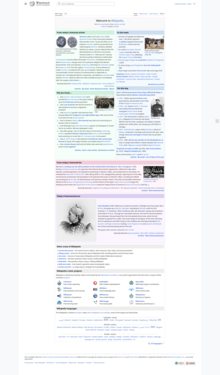
The Main Page of the English Wikipedia running an alpha version of MediaWiki 1.40
|
|
| Original author(s) | |
|---|---|
| Developer(s) | Wikimedia Foundation |
| Initial release | January 25, 2002 |
| Stable release |
1.43.0[1]
|
| Repository | |
| Written in | PHP[2] |
| Operating system | Windows, macOS, Linux, FreeBSD, OpenBSD, Solaris |
| Size | 79.05 MiB (compressed) |
| Available in | 459[3] languages |
| Type | Wiki software |
| License | GPLv2+[4] |
| Website | mediawiki |
MediaWiki is free and open-source wiki software originally developed by Magnus Manske for use on Wikipedia on January 25, 2002, and further improved by Lee Daniel Crocker,[5][6] after which development has been coordinated by the Wikimedia Foundation. It powers several wiki hosting websites across the Internet, as well as most websites hosted by the Wikimedia Foundation including Wikipedia, Wiktionary, Wikimedia Commons, Wikiquote, Meta-Wiki and Wikidata, which define a large part of the set requirements for the software.[7] Besides its usage on Wikimedia sites, MediaWiki has been used as a knowledge management and content management system on websites such as Fandom, wikiHow and major internal installations like Intellipedia and Diplopedia.
MediaWiki is written in the PHP programming language and stores all text content into a database. The software is optimized to efficiently handle large projects, which can have terabytes of content and hundreds of thousands of views per second.[7][8] Because Wikipedia is one of the world's largest and most visited websites, achieving scalability through multiple layers of caching and database replication has been a major concern for developers. Another major aspect of MediaWiki is its internationalization; its interface is available in more than 400 languages.[9] The software has hundreds of configuration settings[10] and more than 1,000 extensions available for enabling various features to be added or changed.[11]
MediaWiki provides a rich core feature set and a mechanism to attach extensions to provide additional functionality.
Due to the strong emphasis on multilingualism in the Wikimedia projects, internationalization and localization has received significant attention by developers. The user interface has been fully or partially translated into more than 400 languages on translatewiki.net,[9] and can be further customized by site administrators (the entire interface is editable through the wiki).
Several extensions, most notably those collected in the MediaWiki Language Extension Bundle, are designed to further enhance the multilingualism and internationalization of MediaWiki.
Installation of MediaWiki requires that the user have administrative privileges on a server running both PHP and a compatible type of SQL database. Some users find that setting up a virtual host is helpful if the majority of one's site runs under a framework (such as Zope or Ruby on Rails) that is largely incompatible with MediaWiki.[12] Cloud hosting can eliminate the need to deploy a new server.[13]
An installation PHP script is accessed via a web browser to initialize the wiki's settings. It prompts the user for a minimal set of required parameters, leaving further changes, such as enabling uploads,[14] adding a site logo,[15] and installing extensions, to be made by modifying configuration settings contained in a file called LocalSettings.php.[16] Some aspects of MediaWiki can be configured through special pages or by editing certain pages; for instance, abuse filters can be configured through a special page,[17] and certain gadgets can be added by creating JavaScript pages in the MediaWiki namespace.[18] The MediaWiki community publishes a comprehensive installation guide.[19]
One of the earliest differences between MediaWiki (and its predecessor, UseModWiki) and other wiki engines was the use of "free links" instead of CamelCase. When MediaWiki was created, it was typical for wikis to require text like "WorldWideWeb" to create a link to a page about the World Wide Web; links in MediaWiki, on the other hand, are created by surrounding words with double square brackets, and any spaces between them are left intact, e.g. [[World Wide Web]]. This change was logical for the purpose of creating an encyclopedia, where accuracy in titles is important.
MediaWiki uses an extensible[20] lightweight wiki markup designed to be easier to use and learn than HTML. Tools exist for converting content such as tables between MediaWiki markup and HTML.[21] Efforts have been made to create a MediaWiki markup spec, but a consensus seems to have been reached that Wikicode requires context-sensitive grammar rules.[22][23] The following side-by-side comparison illustrates the differences between wiki markup and HTML:
| MediaWiki syntax (the "behind the scenes" code used to add formatting to text) |
HTML equivalent (another type of "behind the scenes" code used to add formatting to text) |
Rendered output (seen onscreen by a site viewer) |
|---|---|---|
====A dialogue====
"Take some more [[tea]]," the March Hare said to Alice, very earnestly.
"I've had nothing yet," Alice replied in an offended tone: "so I can't take more."
"You mean you can't take ''less''," said the Hatter: "it's '''very''' easy to take ''more'' than nothing."
|
<h4>A dialogue</h4>
<p>"Take some more <a href="/wiki/Tea" title="Tea">tea</a>," the March Hare said to Alice, very earnestly.</p> <br>
<p>"I've had nothing yet," Alice replied in an offended tone: "so I can't take more."</p> <br>
<p>"You mean you can't take <i>less</i>," said the Hatter: "it's <b>very</b> easy to take <i>more</i> than nothing."</p>
|
A dialogue
"Take some more tea," the March Hare said to Alice, very earnestly. "I've had nothing yet," Alice replied in an offended tone: "so I can't take more." "You mean you can't take less," said the Hatter: "it's very easy to take more than nothing." |
(Quotation above from Alice's Adventures in Wonderland by Lewis Carroll)

MediaWiki's default page-editing tools have been described as somewhat challenging to learn.[24] A survey of students assigned to use a MediaWiki-based wiki found that when they were asked an open question about main problems with the wiki, 24% cited technical problems with formatting, e.g. "Couldn't figure out how to get an image in. Can't figure out how to show a link with words; it inserts a number."[25]
To make editing long pages easier, MediaWiki allows the editing of a subsection of a page (as identified by its header). A registered user can also indicate whether or not an edit is minor. Correcting spelling, grammar or punctuation are examples of minor edits, whereas adding paragraphs of new text is an example of a non-minor edit.
Sometimes while one user is editing, a second user saves an edit to the same part of the page. Then, when the first user attempts to save the page, an edit conflict occurs. The second user is then given an opportunity to merge their content into the page as it now exists following the first user's page save.
MediaWiki's user interface has been localized in many different languages. A language for the wiki content itself can also be set, to be sent in the "Content-Language" HTTP header and "lang" HTML attribute.
VisualEditor has its own integrated wikitext editing interface known as 2017 wikitext editor, the older editing interface is known as 2010 wikitext editor.
MediaWiki has an extensible web API (application programming interface) that provides direct, high-level access to the data contained in the MediaWiki databases. Client programs can use the API to log in, get data, and post changes. The API supports thin web-based JavaScript clients and end-user applications (such as vandal-fighting tools). The API can be accessed by the backend of another web site.[26] An extensive Python bot library, Pywikibot,[27] and a popular semi-automated tool called AutoWikiBrowser, also interface with the API.[28] The API is accessed via URLs such as https://en.wikipedia.org/w/api.php?action=query&list=recentchanges. In this case, the query would be asking Wikipedia for information relating to the last 10 edits to the site. One of the perceived advantages of the API is its language independence; it listens for HTTP connections from clients and can send a response in a variety of formats, such as XML, serialized PHP, or JSON.[29] Client code has been developed to provide layers of abstraction to the API.[30]
Among the features of MediaWiki to assist in tracking edits is a Recent Changes feature that provides a list of recent edits to the wiki. This list contains basic information about those edits such as the editing user, the edit summary, the page edited, as well as any tags (e.g. "possible vandalism")[31] added by customizable abuse filters and other extensions to aid in combating unhelpful edits.[32] On more active wikis, so many edits occur that it is hard to track Recent Changes manually. Anti-vandal software, including user-assisted tools,[33] is sometimes employed on such wikis to process Recent Changes items. Server load can be reduced by sending a continuous feed of Recent Changes to an IRC channel that these tools can monitor, eliminating their need to send requests for a refreshed Recent Changes feed to the API.[34][35]
Another important tool is watchlisting. Each logged-in user has a watchlist to which the user can add whatever pages he or she wishes. When an edit is made to one of those pages, a summary of that edit appears on the watchlist the next time it is refreshed.[36] As with the recent changes page, recent edits that appear on the watchlist contain clickable links for easy review of the article history and specific changes made.
There is also the capability to review all edits made by any particular user. In this way, if an edit is identified as problematic, it is possible to check the user's other edits for issues.
MediaWiki allows one to link to specific versions of articles. This has been useful to the scientific community, in that expert peer reviewers could analyse articles, improve them and provide links to the trusted version of that article.[37]
Navigation through the wiki is largely through internal wikilinks. MediaWiki's wikilinks implement page existence detection, in which a link is colored blue if the target page exists on the local wiki and red if it does not. If a user clicks on a red link, they are prompted to create an article with that title. Page existence detection makes it practical for users to create "wikified" articles—that is, articles containing links to other pertinent subjects—without those other articles being yet in existence.
Interwiki links function much the same way as namespaces. A set of interwiki prefixes can be configured to cause, for instance, a page title of wikiquote:Jimbo Wales to direct the user to the Jimbo Wales article on Wikiquote.[38] Unlike internal wikilinks, interwiki links lack page existence detection functionality, and accordingly there is no way to tell whether a blue interwiki link is broken or not.
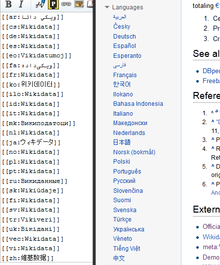
Interlanguage links are the small navigation links that show up in the sidebar in most MediaWiki skins that connect an article with related articles in other languages within the same Wiki family. This can provide language-specific communities connected by a larger context, with all wikis on the same server or each on its own server.[39]
Previously, Wikipedia used interlanguage links to link an article to other articles on the same topic in other editions of Wikipedia. This was superseded by the launch of Wikidata.[40]

Page tabs are displayed at the top of pages. These tabs allow users to perform actions or view pages that are related to the current page. The available default actions include viewing, editing, and discussing the current page. The specific tabs displayed depend on whether the user is logged into the wiki and whether the user has sysop privileges on the wiki. For instance, the ability to move a page or add it to one's watchlist is usually restricted to logged-in users. The site administrator can add or remove tabs by using JavaScript or installing extensions.[41]
Each page has an associated history page from which the user can access every version of the page that has ever existed and generate diffs between two versions of his choice. Users' contributions are displayed not only here, but also via a "user contributions" option on a sidebar. In a 2004 article, Carl Challborn and Teresa Reimann noted that "While this feature may be a slight deviation from the collaborative, 'ego-less' spirit of wiki purists, it can be very useful for educators who need to assess the contribution and participation of individual student users."[42]
MediaWiki provides many features beyond hyperlinks for structuring content. One of the earliest such features is namespaces. One of Wikipedia's earliest problems had been the separation of encyclopedic content from pages pertaining to maintenance and communal discussion, as well as personal pages about encyclopedia editors. Namespaces are prefixes before a page title (such as "User:" or "Talk:") that serve as descriptors for the page's purpose and allow multiple pages with different functions to exist under the same title. For instance, a page titled "[[The Terminator]]", in the default namespace, could describe the 1984 movie starring Arnold Schwarzenegger, while a page titled "[[User:The Terminator]]" could be a profile describing a user who chooses this name as a pseudonym. More commonly, each namespace has an associated "Talk:" namespace, which can be used to discuss its contents, such as "User talk:" or "Template talk:". The purpose of having discussion pages is to allow content to be separated from discussion surrounding the content.[43][44]
Namespaces can be viewed as folders that separate different basic types of information or functionality. Custom namespaces can be added by the site administrators. There are 16 namespaces by default for content, with 2 "pseudo-namespaces" used for dynamically generated "Special:" pages and links to media files. Each namespace on MediaWiki is numbered: content page namespaces have even numbers and their associated talk page namespaces have odd numbers.[45]
Users can create new categories and add pages and files to those categories by appending one or more category tags to the content text. Adding these tags creates links at the bottom of the page that take the reader to the list of all pages in that category, making it easy to browse related articles.[46] The use of categorization to organize content has been described as a combination of:
In addition to namespaces, content can be ordered using subpages. This simple feature provides automatic breadcrumbs of the pattern [[Page title/Subpage title]] from the page after the slash (in this case, "Subpage title") to the page before the slash (in this case, "Page title").

If the feature is enabled, users can customize their stylesheets and configure client-side JavaScript to be executed with every pageview. On Wikipedia, this has led to a large number of additional tools and helpers developed through the wiki and shared among users. For instance, navigation popups is a custom JavaScript tool that shows previews of articles when the user hovers over links and also provides shortcuts for common maintenance tasks.[48]

The entire MediaWiki user interface can be edited through the wiki itself by users with the necessary permissions (typically called "administrators"). This is done through a special namespace with the prefix "MediaWiki:", where each page title identifies a particular user interface message. Using an extension,[49] it is also possible for a user to create personal scripts, and to choose whether certain sitewide scripts should apply to them by toggling the appropriate options in the user preferences page.
The "MediaWiki:" namespace was originally also used for creating custom text blocks that could then be dynamically loaded into other pages using a special syntax. This content was later moved into its own namespace, "Template:".
Templates are text blocks that can be dynamically loaded inside another page whenever that page is requested. The template is a special link in double curly brackets (for example "date=October 2018"), which calls the template (in this case located at Template:Disputed) to load in place of the template call.
Templates are structured documents containing attribute–value pairs. They are defined with parameters, to which are assigned values when transcluded on an article page. The name of the parameter is delimited from the value by an equals sign. A class of templates known as infoboxes is used on Wikipedia to collect and present a subset of information about its subject, usually on the top (mobile view) or top right-hand corner (desktop view) of the document.
Pages in other namespaces can also be transcluded as templates. In particular, a page in the main namespace can be transcluded by prefixing its title with a colon; for example, :MediaWiki transcludes the article "MediaWiki" from the main namespace. Also, it is possible to mark the portions of a page that should be transcluded in several ways, the most basic of which are:[50]
<noinclude>...</noinclude>, which marks content that is not to be transcluded;<includeonly>...</includeonly>, which marks content that is not rendered unless it is transcluded;<onlyinclude>...</onlyinclude>, which marks content that is to be the only content transcluded.A related method, called template substitution (called by adding subst: at the beginning of a template link) inserts the contents of the template into the target page (like a copy and paste operation), instead of loading the template contents dynamically whenever the page is loaded. This can lead to inconsistency when using templates, but may be useful in certain cases, and in most cases requires fewer server resources (the actual amount of savings can vary depending on wiki configuration and the complexity of the template).
Templates have found many different uses. Templates enable users to create complex table layouts that are used consistently across multiple pages, and where only the content of the tables gets inserted using template parameters. Templates are frequently used to identify problems with a Wikipedia article by putting a template in the article. This template then outputs a graphical box stating that the article content is disputed or in need of some other attention, and also categorize it so that articles of this nature can be located. Templates are also used on user pages to send users standard messages welcoming them to the site,[51] giving them awards for outstanding contributions,[52][53] warning them when their behavior is considered inappropriate,[54] notifying them when they are blocked from editing,[55] and so on.
MediaWiki offers flexibility in creating and defining user groups. For instance, it would be possible to create an arbitrary "ninja" group that can block users and delete pages, and whose edits are hidden by default in the recent changes log. It is also possible to set up a group of "autoconfirmed" users that one becomes a member of after making a certain number of edits and waiting a certain number of days.[56] Some groups that are enabled by default are bureaucrats and sysops. Bureaucrats have the power to change other users' rights. Sysops have power over page protection and deletion and the blocking of users from editing. MediaWiki's available controls on editing rights have been deemed sufficient for publishing and maintaining important documents such as a manual of standard operating procedures in a hospital.[57]
MediaWiki comes with a basic set of features related to restricting access, but its original and ongoing design is driven by functions that largely relate to content, not content segregation. As a result, with minimal exceptions (related to specific tools and their related "Special" pages), page access control has never been a high priority in core development and developers have stated that users requiring secure user access and authorization controls should not rely on MediaWiki, since it was never designed for these kinds of situations. For instance, it is extremely difficult to create a wiki where only certain users can read and access some pages.[58] Here, wiki engines like Foswiki, MoinMoin and Confluence provide more flexibility by supporting advanced security mechanisms like access control lists.
The MediaWiki codebase contains various hooks using callback functions to add additional PHP code in an extensible way. This allows developers to write extensions without necessarily needing to modify the core or having to submit their code for review. Installing an extension typically consists of adding a line to the configuration file, though in some cases additional changes such as database updates or core patches are required.
Five main extension points were created to allow developers to add features and functionalities to MediaWiki. Hooks are run every time a certain event happens; for instance, the ArticleSaveComplete hook occurs after a save article request has been processed.[59] This can be used, for example, by an extension that notifies selected users whenever a page edit occurs on the wiki from new or anonymous users.[60] New tags can be created to process data with opening and closing tags (<newtag>...</newtag>).[61] Parser functions can be used to create a new command (...).[62] New special pages can be created to perform a specific function. These pages are dynamically generated. For example, a special page might show all pages that have one or more links to an external site or it might create a form providing user submitted feedback.[63] Skins allow users to customize the look and feel of MediaWiki.[64] A minor extension point allows the use of Amazon S3 to host image files.[65]

Among the most popular extensions is a parser function extension, ParserFunctions, which allows different content to be rendered based on the result of conditional statements.[66] These conditional statements can perform functions such as evaluating whether a parameter is empty, comparing strings, evaluating mathematical expressions, and returning one of two values depending on whether a page exists. It was designed as a replacement for a notoriously inefficient template called Qif.[67] Schindler recounts the history of the ParserFunctions extension as follows:[68]
In 2006 some Wikipedians discovered that through an intricate and complicated interplay of templating features and CSS they could create conditional wiki text, i.e. text that was displayed if a template parameter had a specific value. This included repeated calls of templates within templates, which bogged down the performance of the whole system. The developers faced the choice of either disallowing the spreading of an obviously desired feature by detecting such usage and explicitly disallowing it within the software or offering an efficient alternative. The latter was done by Tim Starling, who announced the introduction of parser functions, wiki text that calls functions implemented in the underlying software. At first, only conditional text and the computation of simple mathematical expressions were implemented, but this already increased the possibilities for wiki editors enormously. With time further parser functions were introduced, finally leading to a framework that allowed the simple writing of extension functions to add arbitrary functionalities, like e.g. geo-coding services or widgets. This time the developers were clearly reacting to the demand of the community, being forced either to fight the solution of the issue that the community had (i.e. conditional text), or offer an improved technical implementation to replace the previous practice and achieve an overall better performance.
Another parser functions extension, StringFunctions, was developed to allow evaluation of string length, string position, and so on. Wikimedia communities, having created awkward workarounds to accomplish the same functionality,[69] clamored for it to be enabled on their projects.[70] Much of its functionality was eventually integrated into the ParserFunctions extension,[71] albeit disabled by default and accompanied by a warning from Tim Starling that enabling string functions would allow users "to implement their own parsers in the ugliest, most inefficient programming language known to man: MediaWiki wikitext with ParserFunctions."[72]
Since 2012 an extension, Scribunto, has existed that allows for the creation of "modules"—wiki pages written in the scripting language Lua—which can then be run within templates and standard wiki pages. Scribunto has been installed on Wikipedia and other Wikimedia sites since 2013 and is used heavily on those sites. Scribunto code runs significantly faster than corresponding wikitext code using ParserFunctions.[73]
Another very popular extension is a citation extension that enables footnotes to be added to pages using inline references.[74] This extension has, however, been criticized for being difficult to use and requiring the user to memorize complex syntax. A gadget called RefToolbar attempts to make it easier to create citations using common templates. MediaWiki has some extensions that are well-suited for academia, such as mathematics extensions[75] and an extension that allows molecules to be rendered in 3D.[76]
A generic Widgets extension exists that allows MediaWiki to integrate with virtually anything. Other examples of extensions that could improve a wiki are category suggestion extensions[77] and extensions for inclusion of Flash Videos,[78] YouTube videos,[79] and RSS feeds.[80] Metavid, a site that archives video footage of the U.S. Senate and House floor proceedings, was created using code extending MediaWiki into the domain of collaborative video authoring.[81]
There are many spambots that search the web for MediaWiki installations and add linkspam to them, despite the fact that MediaWiki uses the nofollow attribute to discourage such attempts at search engine optimization.[82] Part of the problem is that third party republishers, such as mirrors, may not independently implement the nofollow tag on their websites, so marketers can still get PageRank benefit by inserting links into pages when those entries appear on third party websites.[83] Anti-spam extensions have been developed to combat the problem by introducing CAPTCHAs,[84] blacklisting certain URLs,[85] and allowing bulk deletion of pages recently added by a particular user.[86]

MediaWiki comes pre-installed with a standard text-based search. Extensions exist to let MediaWiki use more sophisticated third-party search engines, including Elasticsearch (which since 2014 has been in use on Wikipedia), Lucene[87] and Sphinx.[88]
Various MediaWiki extensions have also been created to allow for more complex, faceted search, on both data entered within the wiki and on metadata such as pages' revision history.[89][90] Semantic MediaWiki is one such extension.[91][92]
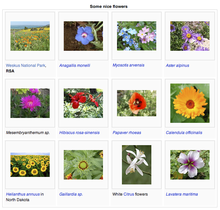
Various extensions to MediaWiki support rich content generated through specialized syntax. These include mathematical formulas using LaTeX, graphical timelines over mathematical plotting, musical scores and Egyptian hieroglyphs.
The software supports a wide variety of uploaded media files, and allows image galleries and thumbnails to be generated with relative ease. There is also support for Exif metadata. MediaWiki operates the Wikimedia Commons, one of the largest free content media archives.
For WYSIWYG editing, VisualEditor is available to use in MediaWiki which simplifying editing process for editors and has been bundled since MediaWiki 1.35.[93] Other extensions exist for handling WYSIWYG editing to different degrees.[94]
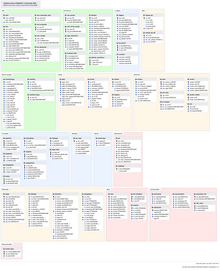
MediaWiki can use either the MySQL/MariaDB, PostgreSQL or SQLite relational database management system. Support for Oracle Database and Microsoft SQL Server has been dropped since MediaWiki 1.34.[95] A MediaWiki database contains several dozen tables, including a page table that contains page titles, page ids, and other metadata;[96] and a revision table to which is added a new row every time an edit is made, containing the page id, a brief textual summary of the change performed, the user name of the article editor (or its IP address the case of an unregistered user) and a timestamp.[97][98]
In a 4½ year period prior to 2008, the MediaWiki database had 170 schema versions.[99] Possibly the largest schema change was done in 2005 with MediaWiki 1.5, when the storage of metadata was separated from that of content, to improve performance flexibility. When this upgrade was applied to Wikipedia, the site was locked for editing, and the schema was converted to the new version in about 22 hours. Some software enhancement proposals, such as a proposal to allow sections of articles to be watched via watchlist, have been rejected because the necessary schema changes would have required excessive Wikipedia downtime.[100]
Because it is used to run one of the highest-traffic sites on the Web, Wikipedia, MediaWiki's performance and scalability have been highly optimized.[101] MediaWiki supports Squid, load-balanced database replication, client-side caching, memcached or table-based caching for frequently accessed processing of query results, a simple static file cache, feature-reduced operation, revision compression, and a job queue for database operations. MediaWiki developers have attempted to optimize the software by avoiding expensive algorithms, database queries, etc., caching every result that is expensive and has temporal locality of reference, and focusing on the hot spots in the code through profiling.[102]
MediaWiki code is designed to allow for data to be written to a read-write database and read from read-only databases, although the read-write database can be used for some read operations if the read-only databases are not yet up to date. Metadata, such as article revision history, article relations (links, categories etc.), user accounts and settings can be stored in core databases and cached; the actual revision text, being more rarely used, can be stored as append-only blobs in external storage. The software is suitable for the operation of large-scale wiki farms such as Wikimedia, which had about 800 wikis as of August 2011. However, MediaWiki comes with no built-in GUI to manage such installations.
Empirical evidence shows most revisions in MediaWiki databases tend to differ only slightly from previous revisions. Therefore, subsequent revisions of an article can be concatenated and then compressed, achieving very high data compression ratios of up to 100×.[102]
For more information on the architecture, such as how it stores wikitext and assembles a page, see External links.
The parser serves as the de facto standard for the MediaWiki syntax, as no formal syntax has been defined. Due to this lack of a formal definition, it has been difficult to create WYSIWYG editors for MediaWiki, although several WYSIWYG extensions do exist, including the popular VisualEditor.
MediaWiki is not designed to be a suitable replacement for dedicated online forum or blogging software,[103] although extensions do exist to allow for both of these.[104][105]
It is common for new MediaWiki users to make certain mistakes, such as forgetting to sign posts with four tildes (~~~~),[106] or manually entering a plaintext signature,[107] due to unfamiliarity with the idiosyncratic particulars involved in communication on MediaWiki discussion pages. On the other hand, the format of these discussion pages has been cited as a strength by one educator, who stated that it provides more fine-grain capabilities for discussion than traditional threaded discussion forums. For example, instead of 'replying' to an entire message, the participant in a discussion can create a hyperlink to a new wiki page on any word from the original page. Discussions are easier to follow since the content is available via hyperlinked wiki page, rather than a series of reply messages on a traditional threaded discussion forum. However, except in few cases, students were not using this capability, possibly because of their familiarity with the traditional linear discussion style and a lack of guidance on how to make the content more 'link-rich'.[108]
MediaWiki by default has little support for the creation of dynamically assembled documents, or pages that aggregate data from other pages. Some research has been done on enabling such features directly within MediaWiki.[109] The Semantic MediaWiki extension provides these features. It is not in use on Wikipedia, but in more than 1,600 other MediaWiki installations.[110] The Wikibase Repository and Wikibase Repository client are however implemented in Wikidata and Wikipedia respectively, and to some extent provides semantic web features, and linking of centrally stored data to infoboxes in various Wikipedia articles.
Upgrading MediaWiki is usually fully automated, requiring no changes to the site content or template programming. Historically troubles have been encountered when upgrading from significantly older versions.[111]
MediaWiki developers have enacted security standards, both for core code and extensions.[112] SQL queries and HTML output are usually done through wrapper functions that handle validation, escaping, filtering for prevention of cross-site scripting and SQL injection.[113] Many security issues have had to be patched after a MediaWiki version release,[114] and accordingly MediaWiki.org states, "The most important security step you can take is to keep your software up to date" by subscribing to the announcement mailing list and installing security updates that are announced.[115]
Support for MediaWiki users consists of:
MediaWiki is free and open-source and is distributed under the terms of the GNU General Public License version 2 or any later version. Its documentation, located at its official website at www.mediawiki.org, is released under the Creative Commons BY-SA 4.0 license, with a set of help pages intended to be freely copied into fresh wiki installations and/or distributed with MediaWiki software in the public domain instead to eliminate legal issues for wikis with other licenses.[119][120] MediaWiki's development has generally favored the use of open-source media formats.[121]
MediaWiki has an active volunteer community for development and maintenance. MediaWiki developers are spread around the world, though with a majority in the United States and Europe. Face-to-face meetings and programming sessions for MediaWiki developers have been held once or several times a year since 2004.[122]
Anyone can submit patches to the project's Git/Gerrit repository.[123] There are also paid programmers who primarily develop projects for the Wikimedia Foundation. MediaWiki developers participate in the Google Summer of Code by facilitating the assignment of mentors to students wishing to work on MediaWiki core and extension projects.[124] During the year prior to November 2012, there were about two hundred developers who had committed changes to the MediaWiki core or extensions.[125] Major MediaWiki releases are generated approximately every six months by taking snapshots of the development branch, which is kept continuously in a runnable state;[126] minor releases, or point releases, are issued as needed to correct bugs (especially security problems). MediaWiki is developed on a continuous integration development model, in which software changes are pushed live to Wikimedia sites on regular basis.[126] MediaWiki also has a public bug tracker, phabricator.wikimedia.org, which runs Phabricator. The site is also used for feature and enhancement requests.

When Wikipedia was launched in January 2001, it ran on an existing wiki software system, UseModWiki. UseModWiki is written in the Perl programming language, and stores all wiki pages in text (.txt) files. This software soon proved to be limiting, in both functionality and performance. In mid-2001, Magnus Manske—a developer and student at the University of Cologne, as well as a Wikipedia editor—began working on new software that would replace UseModWiki, specifically designed for use by Wikipedia. This software was written in the PHP scripting language, and stored all of its information in a MySQL database. The new software was largely developed by August 24, 2001, and a test wiki for it was established shortly thereafter.
The first full implementation of this software was the new Meta Wikipedia on November 9, 2001. There was a desire to have it implemented immediately on the English-language Wikipedia.[127] However, Manske was apprehensive about any potential bugs harming the nascent website during the period of the final exams he had to complete immediately prior to Christmas;[128] this led to the launch on the English-language Wikipedia being delayed until January 25, 2002. The software was then, gradually, deployed on all the Wikipedia language sites of that time. This software was referred to as "the PHP script" and as "phase II", with the name "phase I", retroactively given to the use of UseModWiki.
Increasing usage soon caused load problems to arise again, and soon after, another rewrite of the software began; this time being done by Lee Daniel Crocker, which became known as "phase III". This new software was also written in PHP, with a MySQL backend, and kept the basic interface of the phase II software, but with the added functionality of a wider scalability. The "phase III" software went live on Wikipedia in July 2002.
The Wikimedia Foundation was announced on June 20, 2003. In July, Wikipedia contributor Daniel Mayer suggested the name "MediaWiki" for the software, as a play on "Wikimedia".[129] The MediaWiki name was gradually phased in, beginning in August 2003. The name has frequently caused confusion due to its (intentional) similarity to the "Wikimedia" name (which itself is similar to "Wikipedia").[130] The first version of MediaWiki, 1.1, was released in December 2003.
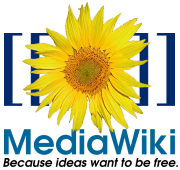
The old product logo was created by Erik Möller, using a flower photograph taken by Florence Nibart-Devouard, and was originally submitted to the logo contest for a new Wikipedia logo, held from July 20 to August 27, 2003.[131][132] The logo came in third place, and was chosen to represent MediaWiki rather than Wikipedia, with the second place logo being used for the Wikimedia Foundation.[133] The double square brackets ([[ ]]) symbolize the syntax MediaWiki uses for creating hyperlinks to other wiki pages; while the sunflower represents the diversity of content on Wikipedia, its constant growth, and the wilderness.[134]
Later, Brooke Vibber, the chief technical officer of the Wikimedia Foundation,[135] took up the role of release manager.[136][101]
Major milestones in MediaWiki's development have included: the categorization system (2004); parser functions, (2006); Flagged Revisions, (2008);[68] the "ResourceLoader", a delivery system for CSS and JavaScript (2011);[137] and the VisualEditor, a "what you see is what you get" (WYSIWYG) editing platform (2013).[138]
The contest of designing a new logo was initiated on June 22, 2020, as the old logo was a bitmap image and had "high details", leading to problems when rendering at high and low resolutions, respectively. After two rounds of voting, the new and current MediaWiki logo designed by Serhio Magpie was selected on October 24, 2020, and officially adopted on April 1, 2021.[139]
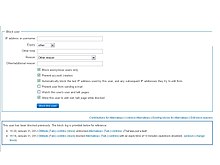
MediaWiki's most famous use has been in Wikipedia and, to a lesser degree, the Wikimedia Foundation's other projects. Fandom, a wiki hosting service formerly known as Wikia, runs on MediaWiki. Other public wikis that run on MediaWiki include wikiHow and SNPedia. WikiLeaks began as a MediaWiki-based site, but is no longer a wiki.
A number of alternative wiki encyclopedias to Wikipedia run on MediaWiki, including Citizendium, Metapedia, Scholarpedia and Conservapedia. MediaWiki is also used internally by a large number of companies, including Novell and Intel.[140][141]
Notable usages of MediaWiki within governments include Intellipedia, used by the United States Intelligence Community, Diplopedia, used by the United States Department of State, and milWiki, a part of milSuite used by the United States Department of Defense. United Nations agencies such as the United Nations Development Programme and INSTRAW chose to implement their wikis using MediaWiki, because "this software runs Wikipedia and is therefore guaranteed to be thoroughly tested, will continue to be developed well into the future, and future technicians on these wikis will be more likely to have exposure to MediaWiki than any other wiki software."[142]
The Free Software Foundation uses MediaWiki to implement the LibrePlanet site.[143]
Users of online collaboration software are familiar with MediaWiki's functions and layout due to its noted use on Wikipedia. A 2006 overview of social software in academia observed that "Compared to other wikis, MediaWiki is also fairly aesthetically pleasing, though simple, and has an easily customized side menu and stylesheet."[144] However, in one assessment in 2006, Confluence was deemed to be a superior product due to its very usable API and ability to better support multiple wikis.[76]
A 2009 study at the University of Hong Kong compared TWiki to MediaWiki. The authors noted that TWiki has been considered as a collaborative tool for the development of educational papers and technical projects, whereas MediaWiki's most noted use is on Wikipedia. Although both platforms allow discussion and tracking of progress, TWiki has a "Report" part that MediaWiki lacks. Students perceived MediaWiki as being easier to use and more enjoyable than TWiki. When asked whether they recommended using MediaWiki for knowledge management course group project, 15 out of 16 respondents expressed their preference for MediaWiki giving answers of great certainty, such as "of course", "for sure".[145] TWiki and MediaWiki both have flexible plug-in architecture.[146]
A 2009 study that compared students' experience with MediaWiki to that with Google Docs found that students gave the latter a much higher rating on user-friendly layout.[147]
A 2021 study conducted by the Brazilian Nuclear Engineering Institute compared a MediaWiki-based knowledge management system against two others that were based on DSpace and Open Journal Systems, respectively.[148] It highlighted ease of use as an advantage of the MediaWiki-based system, noting that because the Wikimedia Foundation had been developing MediaWiki for a site aimed at the general public (Wikipedia), "its user interface was designed to be more user-friendly from start, and has received large user feedback over a long time", in contrast to DSpace's and OJS's focus on niche audiences.[148]
488 languages (not including languages that are supported but have no translations)
A content agency in Sydney focuses on creating high-quality, SEO-optimized content that resonates with your target audience. Their services typically include blog writing, website copy, video production, and other forms of media designed to attract traffic and improve search rankings.
A local SEO agency specializes in improving a business's visibility within a specific geographic area. They focus on optimizing local citations, managing Google My Business profiles, and targeting location-based keywords to attract nearby customers.
SEO, or search engine optimisation, means improving your website's structure, content, and overall performance to rank higher in search results. This leads to more organic traffic, increased brand visibility, and better conversion rates, ultimately supporting your business's growth.